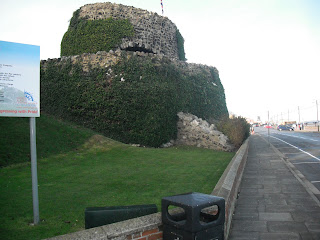Walk 51 Cleethorpes to Immingham (Lincs)
(First leg of English coastal walk – Broadstairs in
Map: 113
Distance: 10 miles, a couple of miles longer if using public transport
Difficulty: quite easy, mostly flat
Terrain: paths and road
Access: Parking at both ends
Public transport: Bus and train service at Cleethorpes - the 46 bus runs from Immingham to Grimsby and Cleethorpes every hour.
Start near the car park at the Discovery Centre to the south of Cleethorpes or walk there from the town. Looking south the Humberston Fitties can be seen in the distance – this is a large conservation area. Also near here is one of the largest caravan sites in the country. Haile Sandfort built in 1918 can be reached by walking across the sands, it was reused as a defence housing soldiers in World War 2. However, be careful if you try this as the tide goes out about a mile and can rush in quickly and dangerously. A large theme park is behind the trees on the shore side.
Walking northwards there is an attractive area of small inland lakes. It is worth walking along the coastal road to appreciate some of the modern art adjacent to the road - this includes a deck chair called ‘forty winks’. The attractive front along this stretch includes a flower bed advertising the Grimsby Telegraph. This reflects the fact that Grimsby and Cleethorpes were merged in 1996. The Greenwich meridian passes through the town and there is allegedly a signpost showing various long distances e.g. New York. I don’t think this is too near the coast edge as I failed to spot it.
Cleethorpes was originally a fishing village and in 1801 had a population of just 264. Clee means clay and thorpe village. In the 1840s it became popular because of the medicinal qualities of the water. In the 1870s day trippers from industrial Yorkshire formed a large group of visitors. Cleethorpes is known locally as Meggie possible because a Meg (an old halfpenny) was the cost of a tram from nearby Grimsby.
Further along the promenade the pier comes into view. It was built in 1873 by the rail companies to encourage more visitors. It suffered badly from fire in 1903 and was rebuilt in 1905 – showing that fires on piers are not just a modern day problem. The current pier is a modernised version. The walk continues past Ross Castle on the left. This too was built by a railway company which was very keen to develop Cleethorpes as a resort. It is named after the secretary of the rail company - Edmund Ross. It was an attraction from 1885 when it was built together with nearby gardens. In later years it became less used and needed restoration in 2007. Now a listed building, many local people refer to it as a folly.
Follow the sea wall to the north out of Cleethorpes. Near to the coast are the floodlights of Grimsby FC who play at Blundell Park. Strangely the ground is actually within the boundaries of Cleethorpes. Past this point roads have to be navigated before entering Grimsby. It is worth a walk to the fishing docks. The town was founded by the Danes in the 9th century and became a fishing and trading port in the 12th century. There is an impressive tower rising out of the docks. This was built in 1852 and is 350 feet high – it provided water for the hydraulically operated dock gates. A stroll along some of the roads in the docks leaves you in doubt that you are in a modern fishing port - with both your eyes and nose! It is the UKs most advanced fishing port but some impressive older buildings remain in the docks. The fishing heritage centre in the town is informative and includes information about what constitutes bad luck on a fishing vessel – a bird tapping on a window is a sign of impending death – to say egg, pig, clergyman or rabbit aboard a trawler could all mean bad luck! During the Second World War a number of Danish fishing boats sailed to Grimsby to escape the German invasion.
After navigating some roads rejoin the coastal walk to the north of Grimsby. I can’t pretend this is a pretty walk with evidence of much industry all the way to Immingham docks. There is a path inland before reaching the docks. I was glad there was as not far from this exit is large chemical works with a public notice warning about the dangers of chemical escapes warning you to leave the area immediately if the sirens and flashing lights start. I noticed a sinister cloud billowing out of here and unbelievably the warning sounds went off. I have rarely walked as fast. On the walk inland to Immingham two fire engines sped past!
Photos show: lakeside area to the south of Cleethorpes; Ross Castle on Cleethorpes promenade; a view to Grimsby from Cleethorpes (Grimsby FC ground is in the picture); the tower at Grimsby fishing dock; the notice outside the chemical factory and finally the smoke billowing from the works which made reading the notice important (as described above).






No comments:
Post a Comment